brakes MERCEDES-BENZ B-CLASS HATCHBACK 2014 Owners Manual
[x] Cancel search | Manufacturer: MERCEDES-BENZ, Model Year: 2014, Model line: B-CLASS HATCHBACK, Model: MERCEDES-BENZ B-CLASS HATCHBACK 2014Pages: 405, PDF Size: 12.24 MB
Page 9 of 405
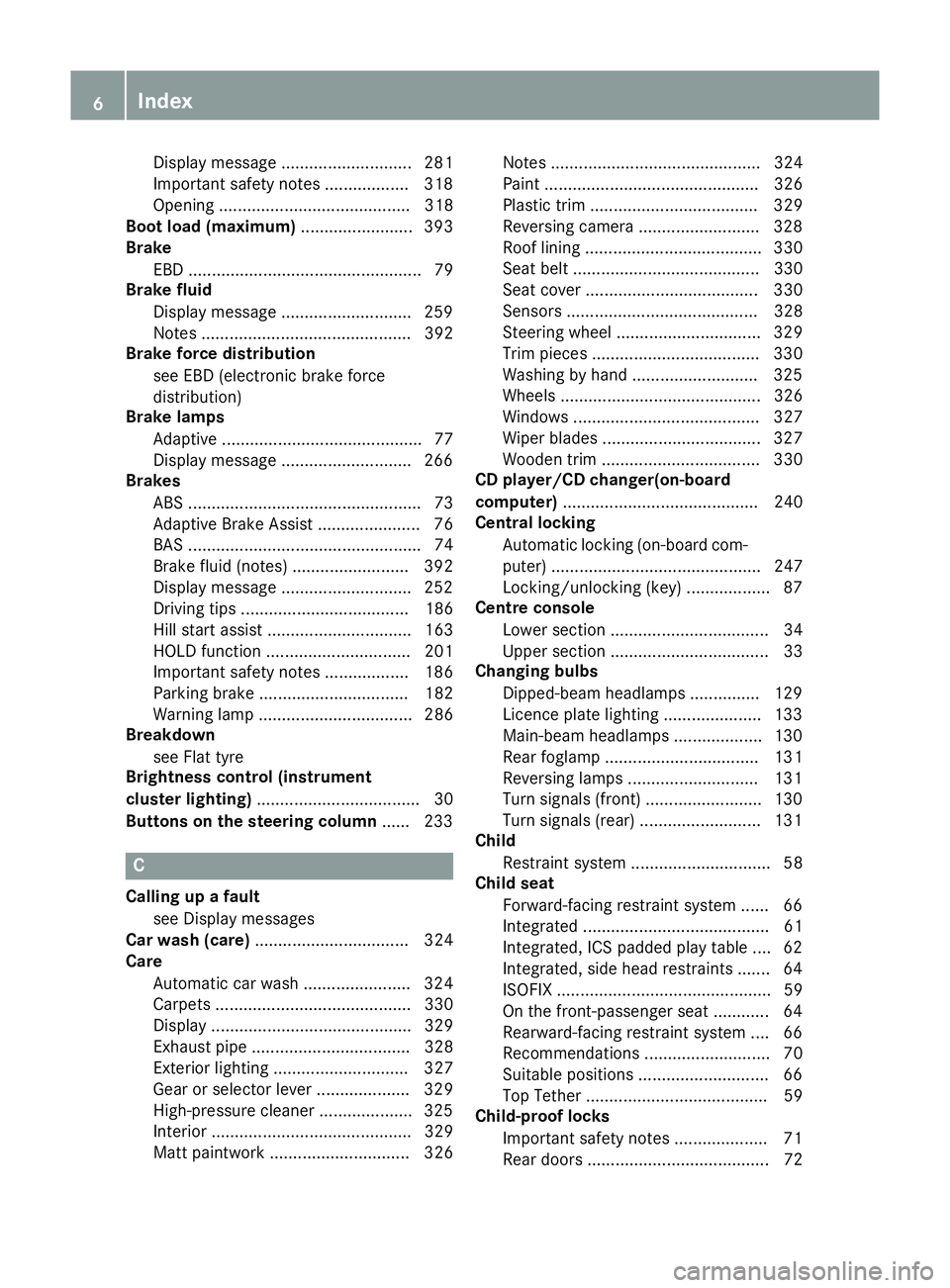
Display message ............................ 281
Important safety note s.................. 318
Opening ......................................... 318
Boot load (maximum) ........................ 393
Brake
EBD .................................................. 79
Brake fluid
Display message ............................ 259
Notes ............................................. 392
Brake force distribution
see EBD (electronic brake force
distribution)
Brake lamps
Adaptive ........................................... 77
Display message ............................ 266
Brakes
ABS .................................................. 73
Adaptive Brake Assist ...................... 76
BAS .................................................. 74
Brake fluid (notes) ......................... 392
Display message ............................ 252
Driving tips .................................... 186
Hill start assist ............................... 163
HOLD function ............................... 201
Important safety notes .................. 186
Parking brake ................................ 182
Warning lamp ................................. 286
Breakdown
see Flat tyre
Brightness control (instrument
cluster lighting) ................................... 30
Buttons on the steering column ...... 233C
Calling up a fault see Display messages
Car wash (care) ................................. 324
Care
Automatic car wash ....................... 324
Carpets .......................................... 330
Display ........................................... 329
Exhaust pipe .................................. 328
Exterior lighting ............................. 327
Gear or selector lever .................... 329
High-pressure cleaner .................... 325
Interior ........................................... 329
Matt paintwork .............................. 326 Note
s............................................. 324
Paint .............................................. 326
Plastic trim .................................... 329
Reversing camera .......................... 328
Roof lining ...................................... 330
Seat belt ........................................ 330
Seat cove r..................................... 330
Sensors ......................................... 328
Steering wheel ............................... 329
Trim pieces .................................... 330
Washing by hand ........................... 325
Wheels ........................................... 326
Windows ........................................ 327
Wiper blades .................................. 327
Wooden trim .................................. 330
CD player/CD changer(on-board
computer) .......................................... 240
Central locking
Automatic locking (on-board com-puter) ............................................. 247
Locking/unlocking (key) .................. 87
Centre console
Lower section .................................. 34
Upper section .................................. 33
Changing bulbs
Dipped-beam headlamp s............... 129
Licence plate lighting ..................... 133
Main-beam headlamp s................... 130
Rear foglamp ................................. 131
Reversing lamps ............................ 131
Turn signals (front) ......................... 130
Turn signals (rear) .......................... 131
Child
Restraint system .............................. 58
Child seat
Forward-facing restraint system ...... 66
Integrated ........................................ 61
Integrated, ICS padded play table .... 62
Integrated, side head restraints ....... 64
ISOFIX .............................................. 59
On the front-passenger seat ............ 64
Rearward-facing restraint system .... 66
Recommendations ........................... 70
Suitable positions ............................ 66
Top Tether ....................................... 59
Child-proof locks
Important safety notes .................... 71
Rear doors ....................................... 72 6
Index
Page 12 of 405
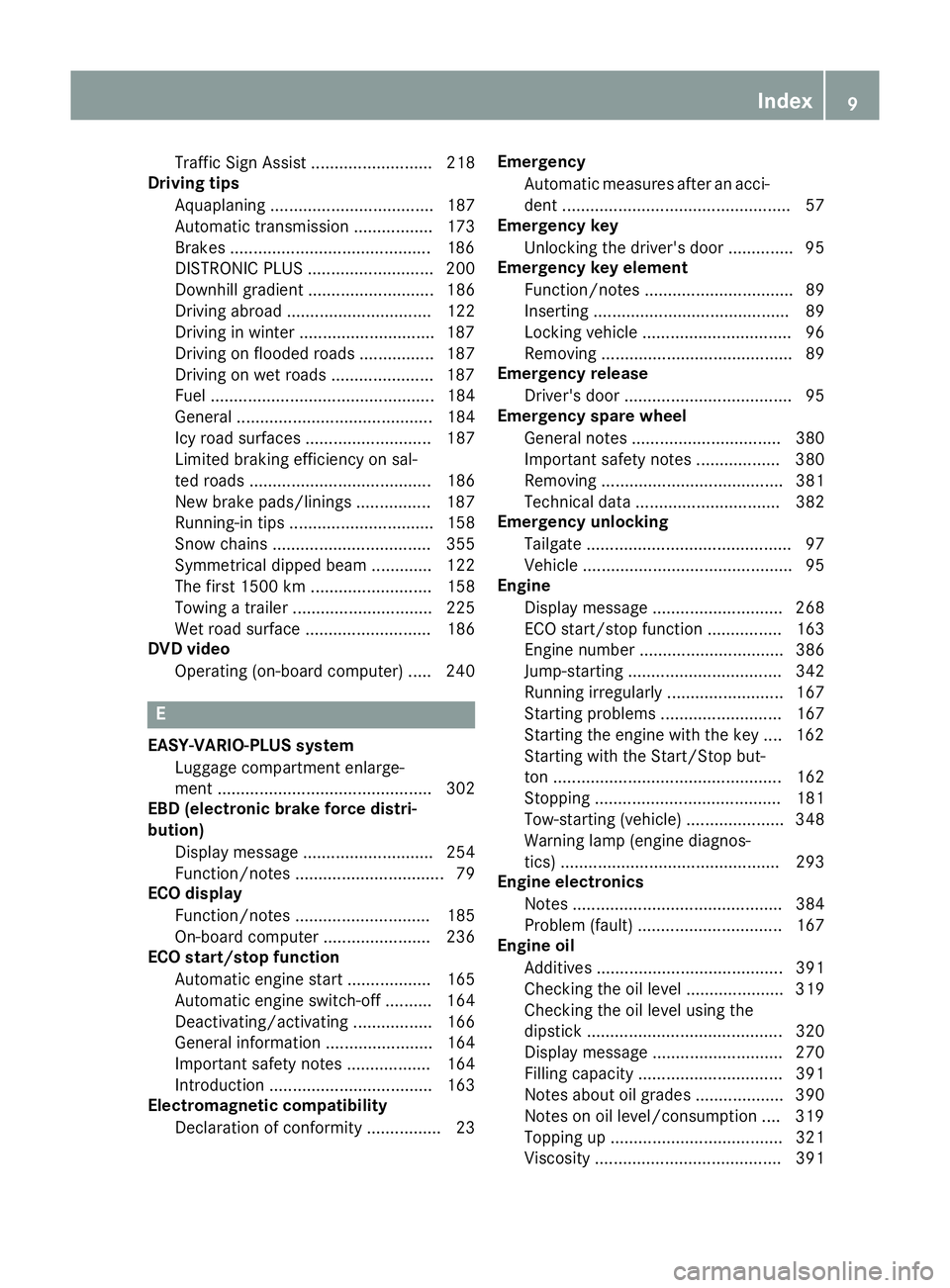
Traffic Sign Assist .......................... 218
Driving tips
Aquaplaning ................................... 187
Automatic transmission ................. 173
Brakes ...........................................1 86
DISTRONIC PLUS ........................... 200
Downhill gradient ........................... 186
Driving abroad ............................... 122
Driving in winter ............................ .187
Driving on flooded roads ................ 187
Driving on wet roads ..................... .187
Fuel ................................................ 184
General .......................................... 184
Icy road surfaces ........................... 187
Limited braking efficiency on sal-
ted roads ....................................... 186
New brake pads/linings ................ 187
Running-in tips ............................... 158
Snow chains .................................. 355
Symmetrical dipped bea m............. 122
The first 1500 km .......................... 158
Towing a trailer .............................. 225
Wet road surface ........................... 186
DVD video
Operating (on-board computer) ..... 240 E
EASY-VARIO-PLUS system Luggage compartment enlarge-
ment .............................................. 302
EBD (electronic brake force distri-
bution)
Display message ............................ 254
Function/note s................................ 79
ECO display
Function/note s............................. 185
On-board computer ....................... 236
ECO start/stop function
Automatic engine start .................. 165
Automatic engine switch-off .......... 164
Deactivating/activating ................. 166
General information ....................... 164
Important safety notes .................. 164
Introduction ................................... 163
Electromagnetic compatibility
Declaration of conformity ................ 23 Emergency
Automatic measures after an acci-
dent ................................................. 57
Emergency key
Unlocking the driver's door .............. 95
Emergency key element
Function/note s................................ 89
Inserting .......................................... 89
Locking vehicle ................................ 96
Removing ......................................... 89
Emergency release
Driver's door .................................... 95
Emergency spare wheel
General notes ................................ 380
Important safety notes .................. 380
Removing ....................................... 381
Technical data ............................... 382
Emergency unlocking
Tailgate ............................................ 97
Vehicle ............................................. 95
Engine
Display message ............................ 268
ECO start/stop function ................ 163
Engine number ............................... 386
Jump-starting ................................. 342
Running irregularly ......................... 167
Starting problems .......................... 167
Starting the engine with the key .... 162
Starting with the Start/Stop but-
ton ................................................. 162
Stopping ........................................ 181
Tow-starting (vehicle) ..................... 348
Warning lamp (engine diagnos-
tics) ............................................... 293
Engine electronics
Notes ............................................. 384
Problem (fault) ............................... 167
Engine oil
Additives ........................................ 391
Checking the oil level ..................... 319
Checking the oil level using the
dipstick .......................................... 320
Display message ............................ 270
Filling capacity ............................... 391
Notes about oil grade s................... 390
Notes on oil level/consumption .... 319
Topping up ..................................... 321
Viscosity ........................................ 391 Index
9
Page 23 of 405
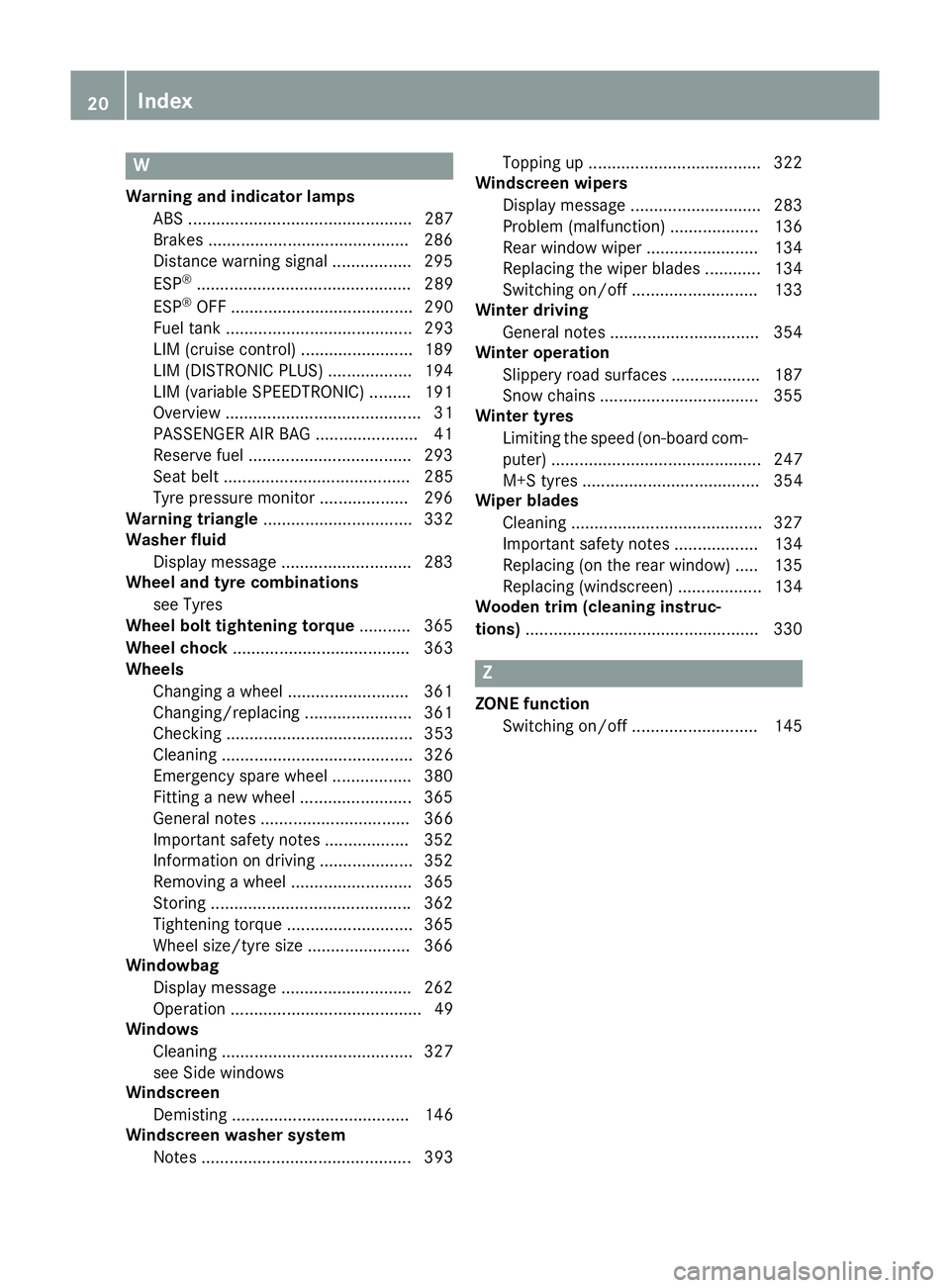
W
Warning and indicator lamps ABS ................................................ 287
Brakes .......................................... .286
Distance warning signal ................. 295
ESP ®
.............................................. 289
ESP ®
OFF ....................................... 290
Fuel tank ........................................ 293
LIM (cruise control) ........................ 189
LIM (DISTRONIC PLUS) .................. 194
LIM (variable SPEEDTRONIC) ......... 191
Overview .......................................... 31
PASSENGER AIR BAG ..................... .41
Reserve fuel .................................. .293
Seat belt ........................................ 285
Tyre pressure monitor ................... 296
Warning triangle ................................ 332
Washer fluid
Display message ............................ 283
Wheel and tyre combinations
see Tyres
Wheel bolt tightening torque ........... 365
Wheel chock ...................................... 363
Wheels
Changing a wheel .......................... 361
Changing/replacing ....................... 361
Checking ........................................ 353
Cleaning ......................................... 326
Emergency spare wheel ................. 380
Fitting a new wheel ........................ 365
General notes ................................ 366
Important safety notes .................. 352
Information on driving .................... 352
Removing a wheel .......................... 365
Storing .......................................... .362
Tightening torque ........................... 365
Wheel size/tyre size ..................... .366
Windowbag
Display message ............................ 262
Operation ......................................... 49
Windows
Cleaning ......................................... 327
see Side windows
Windscreen
Demisting ...................................... 146
Windscreen washer system
Notes ............................................. 393 Topping up ..................................... 322
Windscreen wipers
Display message ............................ 283
Problem (malfunction) ................... 136
Rear window wiper ........................ 134
Replacing the wiper blades ............ 134
Switching on/off ........................... 133
Winter driving
General notes ................................ 354
Winter operation
Slippery road surfaces ................... 187
Snow chains .................................. 355
Winter tyres
Limiting the speed (on-board com-
puter) ............................................. 247
M+S tyres ...................................... 354
Wiper blades
Cleaning ......................................... 327
Important safety notes .................. 134
Replacing (on the rear window) ..... 135
Replacing (windscreen) .................. 134
Wooden trim (cleaning instruc-
tions) ................................................. .330 Z
ZONE function Switching on/off ........................... 145 20
Index
Page 28 of 405
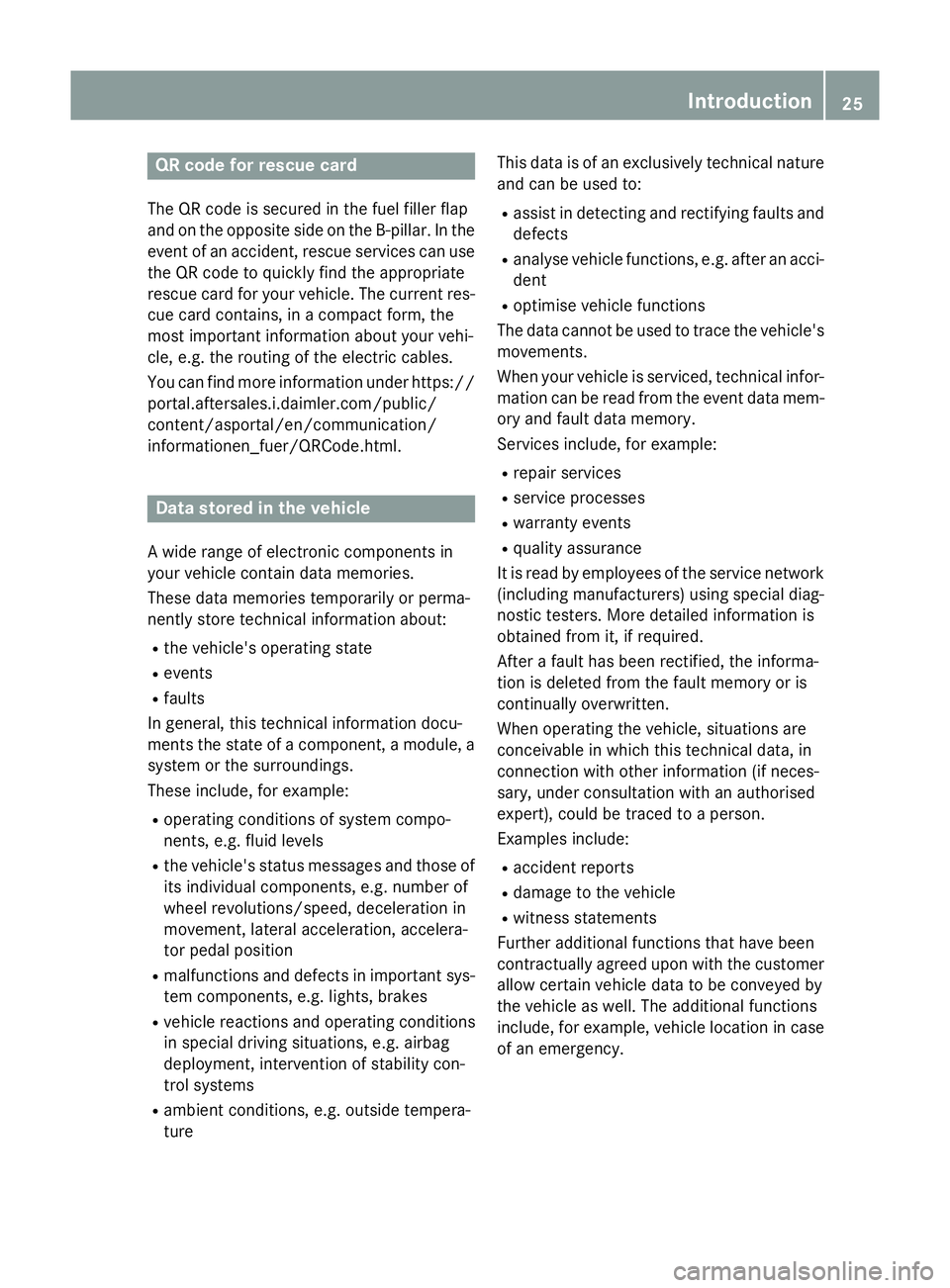
QR code for rescue card
The QR code is secured in the fuel filler flap
and on the opposite side on the B-pillar. In the
event of an accident, rescue services can use
the QR code to quickly find the appropriate
rescue card for your vehicle. The current res- cue card contains, in a compact form, the
most important information about your vehi-
cle, e.g. the routing of the electric cables.
You can find more information under https:// portal.aftersales.i.daimler.com/public/
content/asportal/en/communication/
informationen_fuer/QRCode.html. Data stored in the vehicle
A wide range of electronic components in
your vehicle contain data memories.
These data memories temporarily or perma-
nently store technical information about: R the vehicle's operating state
R events
R faults
In general, this technical information docu-
ments the state of a component, a module, a system or the surroundings.
These include, for example:
R operating conditions of system compo-
nents, e.g. fluid levels
R the vehicle's status messages and those of
its individual components, e.g. number of
wheel revolutions/speed, deceleration in
movement, lateral acceleration, accelera-
tor pedal position
R malfunctions and defects in important sys-
tem components, e.g. lights, brakes
R vehicle reactions and operating conditions
in special driving situations, e.g. airbag
deployment, intervention of stability con-
trol systems
R ambient conditions, e.g. outside tempera-
ture This data is of an exclusively technical nature
and can be used to:
R assist in detecting and rectifying faults and
defects
R analyse vehicle functions, e.g. after an acci-
dent
R optimise vehicle functions
The data cannot be used to trace the vehicle's movements.
When your vehicle is serviced, technical infor-
mation can be read from the event data mem- ory and fault data memory.
Services include, for example:
R repair services
R service processes
R warranty events
R quality assurance
It is read by employees of the service network (including manufacturers) using special diag-
nostic testers. More detailed information is
obtained from it, if required.
After a fault has been rectified, the informa-
tion is deleted from the fault memory or is
continually overwritten.
When operating the vehicle, situations are
conceivable in which this technical data, in
connection with other information (if neces-
sary, under consultation with an authorised
expert), could be traced to a person.
Examples include:
R accident reports
R damage to the vehicle
R witness statements
Further additional functions that have been
contractually agreed upon with the customer
allow certain vehicle data to be conveyed by
the vehicle as well. The additional functions
include, for example, vehicle location in case of an emergency. Introduction
25 Z
Page 34 of 405
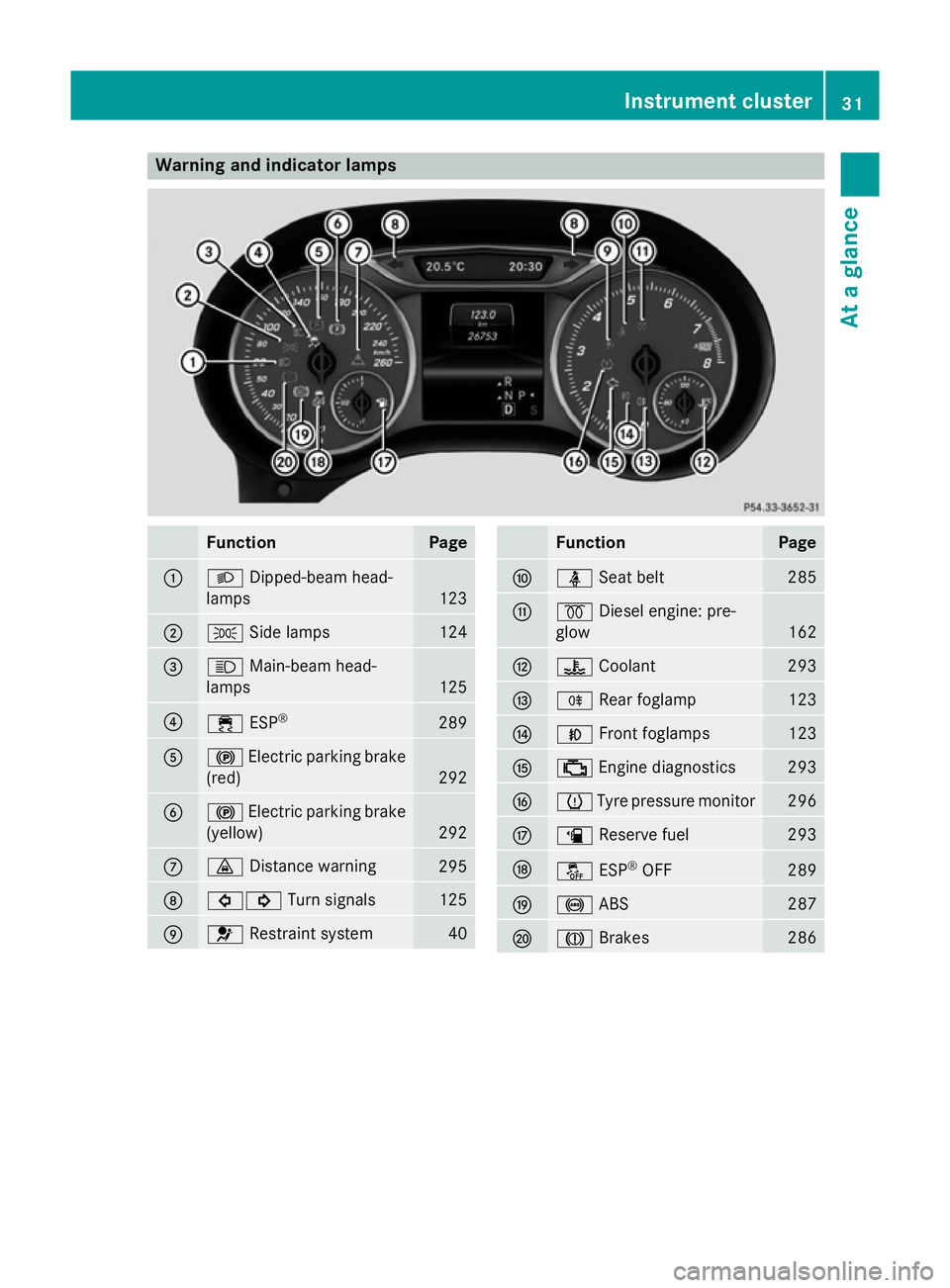
Warning and indicator lamps
Function Page
:
L
Dipped-beam head-
lamps 123
;
T
Side lamps 124
=
K
Main-beam head-
lamps 125
?
÷
ESP® 289
A
!
Electric parking brake
(red) 292
B
!
Electric parking brake
(yellow) 292
C
·
Distance warning 295
D
#!
Turn signals 125
E
6
Restraint system 40 Function Page
F
ü
Seat belt 285
G
%
Diesel engine: pre-
glow 162
H
?
Coolant 293
I
R
Rear foglamp 123
J
N
Front foglamps 123
K
;
Engine diagnostics 293
L
h
Tyre pressure monitor 296
M
æ
Reserve fuel 293
N
å
ESP®
OFF 289
O
!
ABS 287
P
J
Brakes 286Instrument cluster
31At a glance
Page 77 of 405
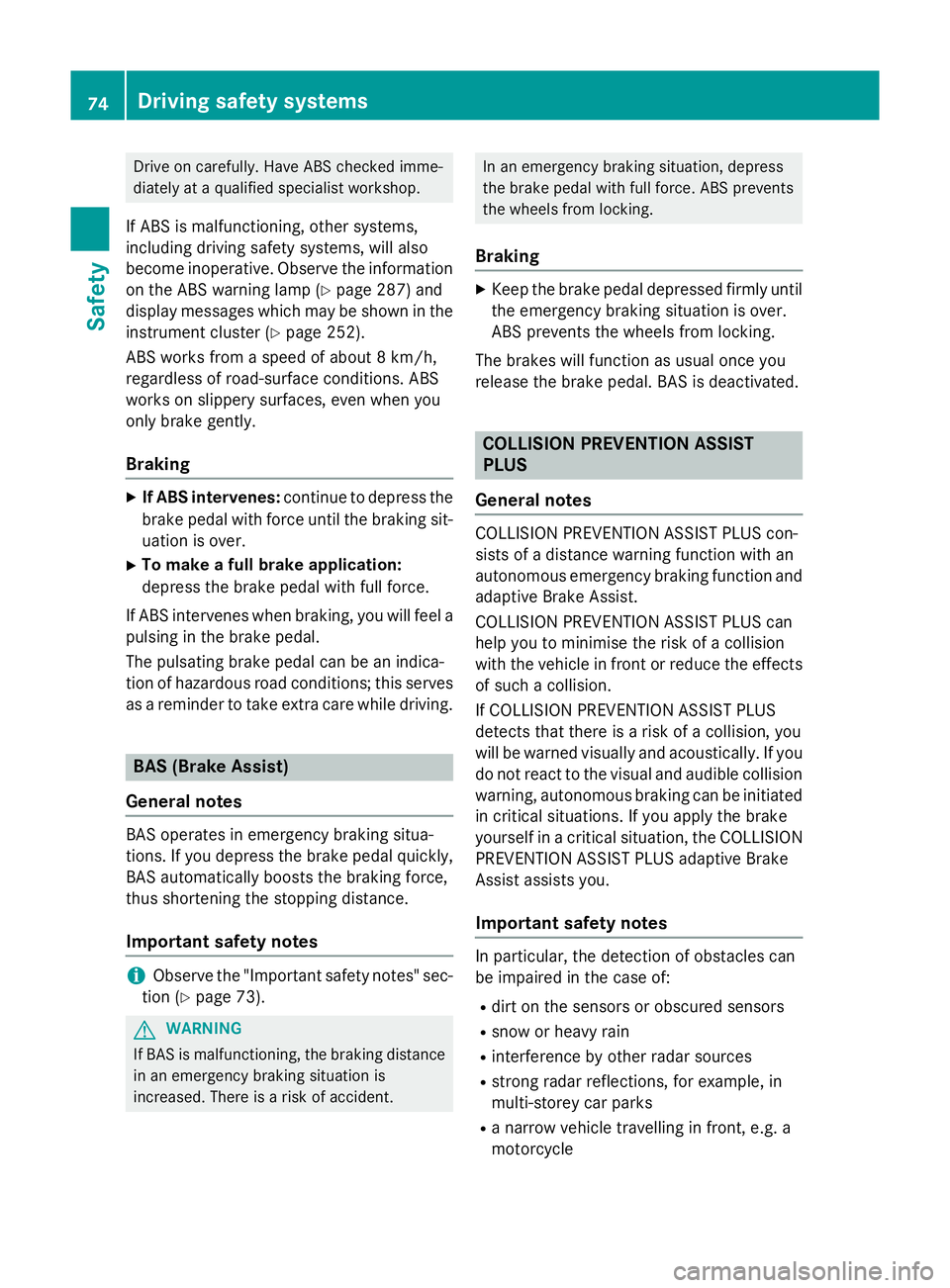
Drive on carefully. Have ABS checked imme-
diately at a qualified specialist workshop.
If ABS is malfunctioning, other systems,
including driving safety systems, will also
become inoperative. Observe the information on the ABS warning lamp (Y page 287) and
display messages which may be shown in the
instrument cluster (Y page 252).
ABS works from a speed of about 8 km/h,
regardless of road-surface conditions. ABS
works on slippery surfaces, even when you
only brake gently.
Braking X
If ABS intervenes: continue to depress the
brake pedal with force until the braking sit- uation is over.
X To make a full brake application:
depress the brake pedal with full force.
If ABS intervenes when braking, you will feel a
pulsing in the brake pedal.
The pulsating brake pedal can be an indica-
tion of hazardous road conditions; this serves as a reminder to take extra care while driving. BAS (Brake Assist)
General notes BAS operates in emergency braking situa-
tions. If you depress the brake pedal quickly,
BAS automatically boosts the braking force,
thus shortening the stopping distance.
Important safety notes i
Observe the "Important safety notes" sec-
tion (Y page 73). G
WARNING
If BAS is malfunctioning, the braking distance
in an emergency braking situation is
increased. There is a risk of accident. In an emergency braking situation, depress
the brake pedal with full force. ABS prevents
the wheels from locking.
Braking X
Keep the brake pedal depressed firmly until
the emergency braking situation is over.
ABS prevents the wheels from locking.
The brakes will function as usual once you
release the brake pedal. BAS is deactivated. COLLISION PREVENTION ASSIST
PLUS
General notes COLLISION PREVENTION ASSIST PLUS con-
sists of a distance warning function with an
autonomous emergency braking function and
adaptive Brake Assist.
COLLISION PREVENTION ASSIST PLUS can
help you to minimise the risk of a collision
with the vehicle in front or reduce the effects of such a collision.
If COLLISION PREVENTION ASSIST PLUS
detects that there is a risk of a collision, you
will be warned visually and acoustically. If you
do not react to the visual and audible collision warning, autonomous braking can be initiated
in critical situations. If you apply the brake
yourself in a critical situation, the COLLISION PREVENTION ASSIST PLUS adaptive Brake
Assist assists you.
Important safety notes In particular, the detection of obstacles can
be impaired in the case of:
R dirt on the sensors or obscured sensors
R snow or heavy rain
R interference by other radar sources
R strong radar reflections, for example, in
multi-storey car parks
R a narrow vehicle travelling in front, e.g. a
motorcycle 74
Driving safety systemsSafety
Page 79 of 405
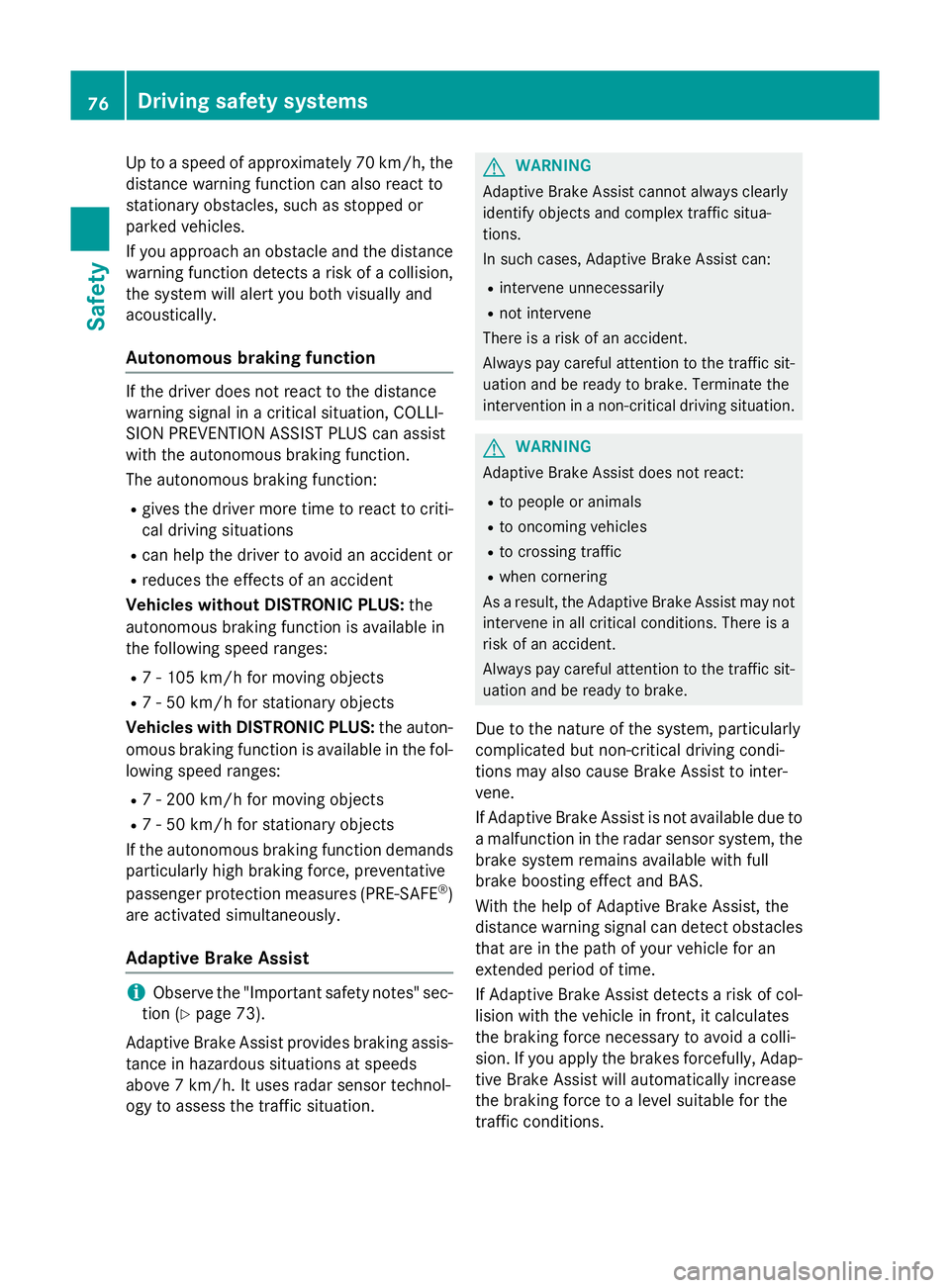
Up to a speed of approximately 70 km/h, the
distance warning function can also react to
stationary obstacles, such as stopped or
parked vehicles.
If you approach an obstacle and the distance
warning function detects a risk of a collision, the system will alert you both visually and
acoustically.
Autonomous braking function If the driver does not react to the distance
warning signal in a critical situation, COLLI-
SION PREVENTION ASSIST PLUS can assist
with the autonomous braking function.
The autonomous braking function:
R gives the driver more time to react to criti-
cal driving situations
R can help the driver to avoid an accident or
R reduces the effects of an accident
Vehicles without DISTRONIC PLUS: the
autonomous braking function is available in
the following speed ranges:
R 7 - 105 km/h for moving objects
R 7 - 50 km/h for stationary objects
Vehicles with DISTRONIC PLUS: the auton-
omous braking function is available in the fol- lowing speed ranges:
R 7 - 200 km/h for moving objects
R 7 - 50 km/h for stationary objects
If the autonomous braking function demands
particularly high braking force, preventative
passenger protection measures (PRE-SAFE ®
)
are activated simultaneously.
Adaptive Brake Assist i
Observe the "Important safety notes" sec-
tion (Y page 73).
Adaptive Brake Assist provides braking assis- tance in hazardous situations at speeds
above 7 km/h. It uses radar sensor technol-
ogy to assess the traffic situation. G
WARNING
Adaptive Brake Assist cannot always clearly
identify objects and complex traffic situa-
tions.
In such cases, Adaptive Brake Assist can:
R intervene unnecessarily
R not intervene
There is a risk of an accident.
Always pay careful attention to the traffic sit- uation and be ready to brake. Terminate the
intervention in a non-critical driving situation. G
WARNING
Adaptive Brake Assist does not react:
R to people or animals
R to oncoming vehicles
R to crossing traffic
R when cornering
As a result, the Adaptive Brake Assist may not intervene in all critical conditions. There is a
risk of an accident.
Always pay careful attention to the traffic sit- uation and be ready to brake.
Due to the nature of the system, particularly
complicated but non-critical driving condi-
tions may also cause Brake Assist to inter-
vene.
If Adaptive Brake Assist is not available due to a malfunction in the radar sensor system, thebrake system remains available with full
brake boosting effect and BAS.
With the help of Adaptive Brake Assist, the
distance warning signal can detect obstacles
that are in the path of your vehicle for an
extended period of time.
If Adaptive Brake Assist detects a risk of col-
lision with the vehicle in front, it calculates
the braking force necessary to avoid a colli-
sion. If you apply the brakes forcefully, Adap-
tive Brake Assist will automatically increase
the braking force to a level suitable for the
traffic conditions. 76
Driving safety systemsSafety
Page 80 of 405
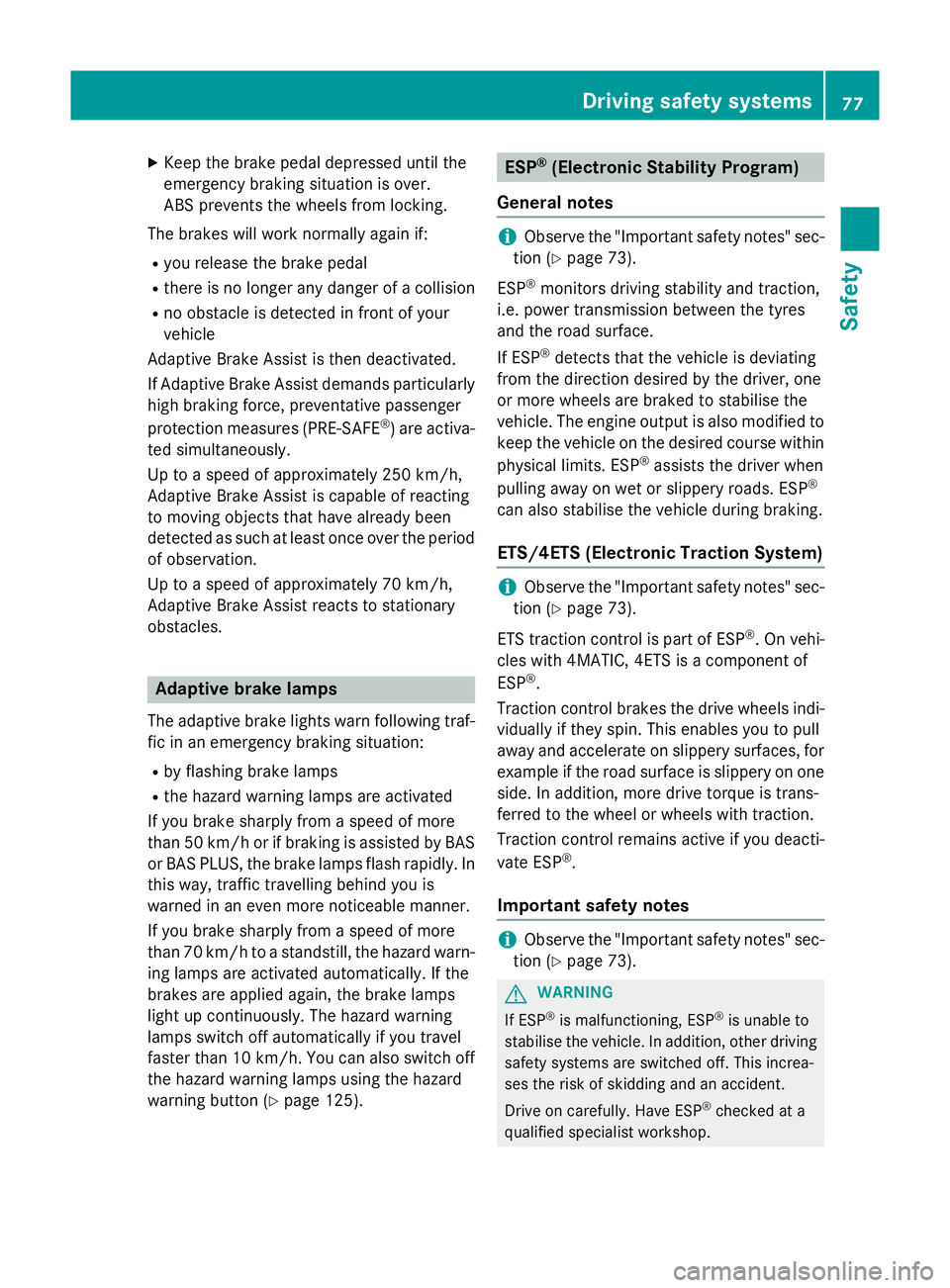
X
Keep the brake pedal depressed until the
emergency braking situation is over.
ABS prevents the wheels from locking.
The brakes will work normally again if: R you release the brake pedal
R there is no longer any danger of a collision
R no obstacle is detected in front of your
vehicle
Adaptive Brake Assist is then deactivated.
If Adaptive Brake Assist demands particularly
high braking force, preventative passenger
protection measures (PRE-SAFE ®
) are activa-
ted simultaneously.
Up to a speed of approximately 250 km/h,
Adaptive Brake Assist is capable of reacting
to moving objects that have already been
detected as such at least once over the period of observation.
Up to a speed of approximately 70 km/h,
Adaptive Brake Assist reacts to stationary
obstacles. Adaptive brake lamps
The adaptive brake lights warn following traf- fic in an emergency braking situation:
R by flashing brake lamps
R the hazard warning lamps are activated
If you brake sharply from a speed of more
than 50 km/h or if braking is assisted by BAS
or BAS PLUS, the brake lamps flash rapidly. In this way, traffic travelling behind you is
warned in an even more noticeable manner.
If you brake sharply from a speed of more
than 70 km/h to a standstill, the hazard warn-
ing lamps are activated automatically. If the
brakes are applied again, the brake lamps
light up continuously. The hazard warning
lamps switch off automatically if you travel
faster than 10 km/h. You can also switch off
the hazard warning lamps using the hazard
warning button (Y page 125). ESP
®
(Electronic Stability Program)
General notes i
Observe the "Important safety notes" sec-
tion (Y page 73).
ESP ®
monitors driving stability and traction,
i.e. power transmission between the tyres
and the road surface.
If ESP ®
detects that the vehicle is deviating
from the direction desired by the driver, one
or more wheels are braked to stabilise the
vehicle. The engine output is also modified to keep the vehicle on the desired course within
physical limits. ESP ®
assists the driver when
pulling away on wet or slippery roads. ESP ®
can also stabilise the vehicle during braking.
ETS/4ETS (Electronic Traction System) i
Observe the "Important safety notes" sec-
tion (Y page 73).
ETS traction control is part of ESP ®
. On vehi-
cles with 4MATIC, 4ETS is a component of
ESP ®
.
Traction control brakes the drive wheels indi-
vidually if they spin. This enables you to pull
away and accelerate on slippery surfaces, for
example if the road surface is slippery on one side. In addition, more drive torque is trans-
ferred to the wheel or wheels with traction.
Traction control remains active if you deacti-
vate ESP ®
.
Important safety notes i
Observe the "Important safety notes" sec-
tion (Y page 73). G
WARNING
If ESP ®
is malfunctioning, ESP ®
is unable to
stabilise the vehicle. In addition, other driving
safety systems are switched off. This increa-
ses the risk of skidding and an accident.
Drive on carefully. Have ESP ®
checked at a
qualified specialist workshop. Driving safety systems
77Safety Z
Page 168 of 405
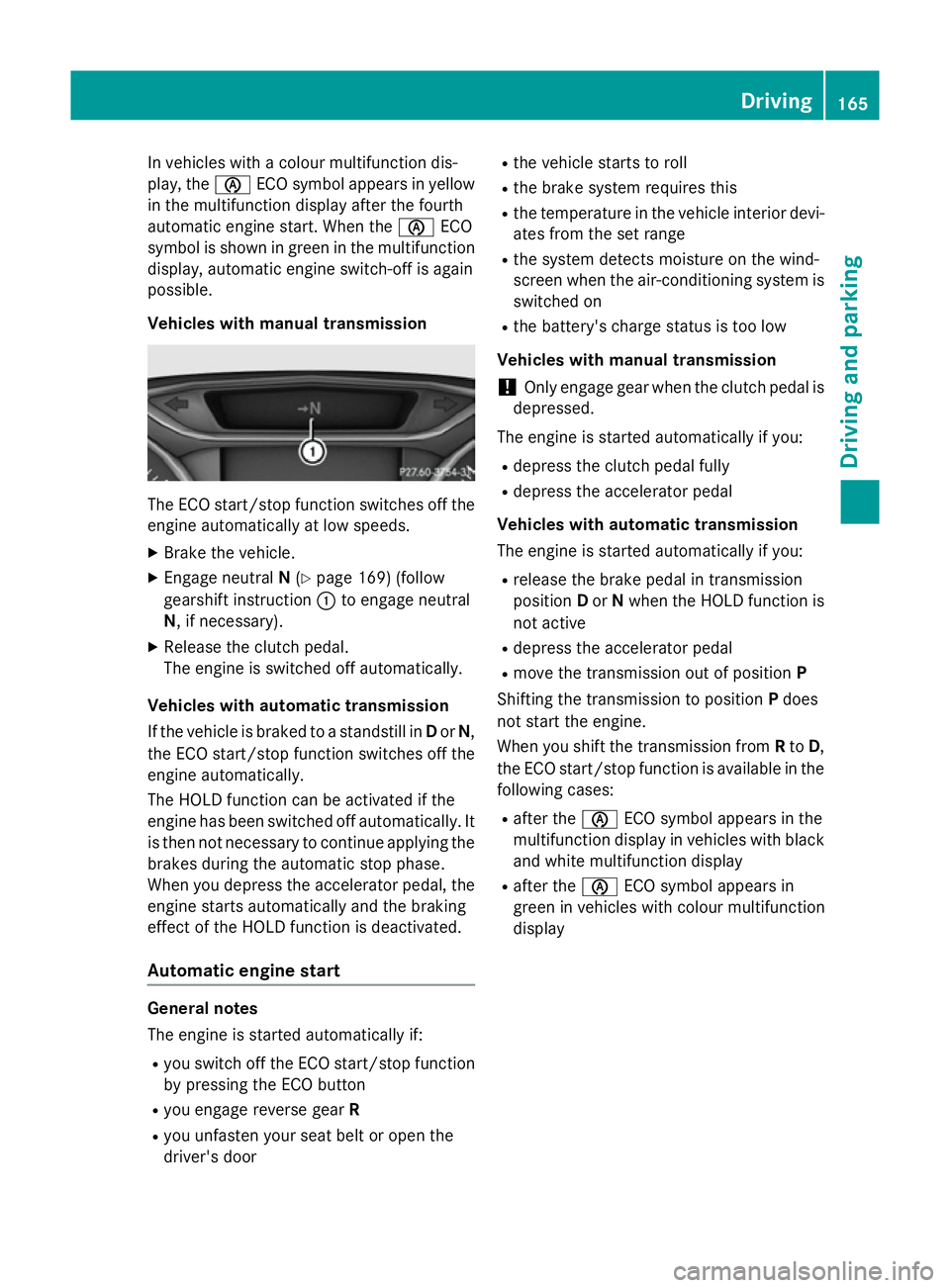
In vehicles with a colour multifunction dis-
play, the èECO symbol appears in yellow
in the multifunction display after the fourth
automatic engine start. When the èECO
symbol is shown in green in the multifunction
display, automatic engine switch-off is again
possible.
Vehicles with manual transmission The ECO start/stop function switches off the
engine automatically at low speeds.
X Brake the vehicle.
X Engage neutral N(Y page 169) (follow
gearshift instruction :to engage neutral
N, if necessary).
X Release the clutch pedal.
The engine is switched off automatically.
Vehicles with automatic transmission
If the vehicle is braked to a standstill in Dor N,
the ECO start/stop function switches off the engine automatically.
The HOLD function can be activated if the
engine has been switched off automatically. It is then not necessary to continue applying the
brakes during the automatic stop phase.
When you depress the accelerator pedal, the engine starts automatically and the braking
effect of the HOLD function is deactivated.
Automatic engine start General notes
The engine is started automatically if:
R
you switch off the ECO start/stop function
by pressing the ECO button
R you engage reverse gear R
R you unfasten your seat belt or open the
driver's door R
the vehicle starts to roll
R the brake system requires this
R the temperature in the vehicle interior devi-
ates from the set range
R the system detects moisture on the wind-
screen when the air-conditioning system is
switched on
R the battery's charge status is too low
Vehicles with manual transmission
! Only engage gear when the clutch pedal is
depressed.
The engine is started automatically if you:
R depress the clutch pedal fully
R depress the accelerator pedal
Vehicles with automatic transmission
The engine is started automatically if you: R release the brake pedal in transmission
position Dor Nwhen the HOLD function is
not active
R depress the accelerator pedal
R move the transmission out of position P
Shifting the transmission to position Pdoes
not start the engine.
When you shift the transmission from Rto D,
the ECO start/stop function is available in the following cases:
R after the èECO symbol appears in the
multifunction display in vehicles with black
and white multifunction display
R after the èECO symbol appears in
green in vehicles with colour multifunction
display Driving
165Driving and parking Z
Page 171 of 405
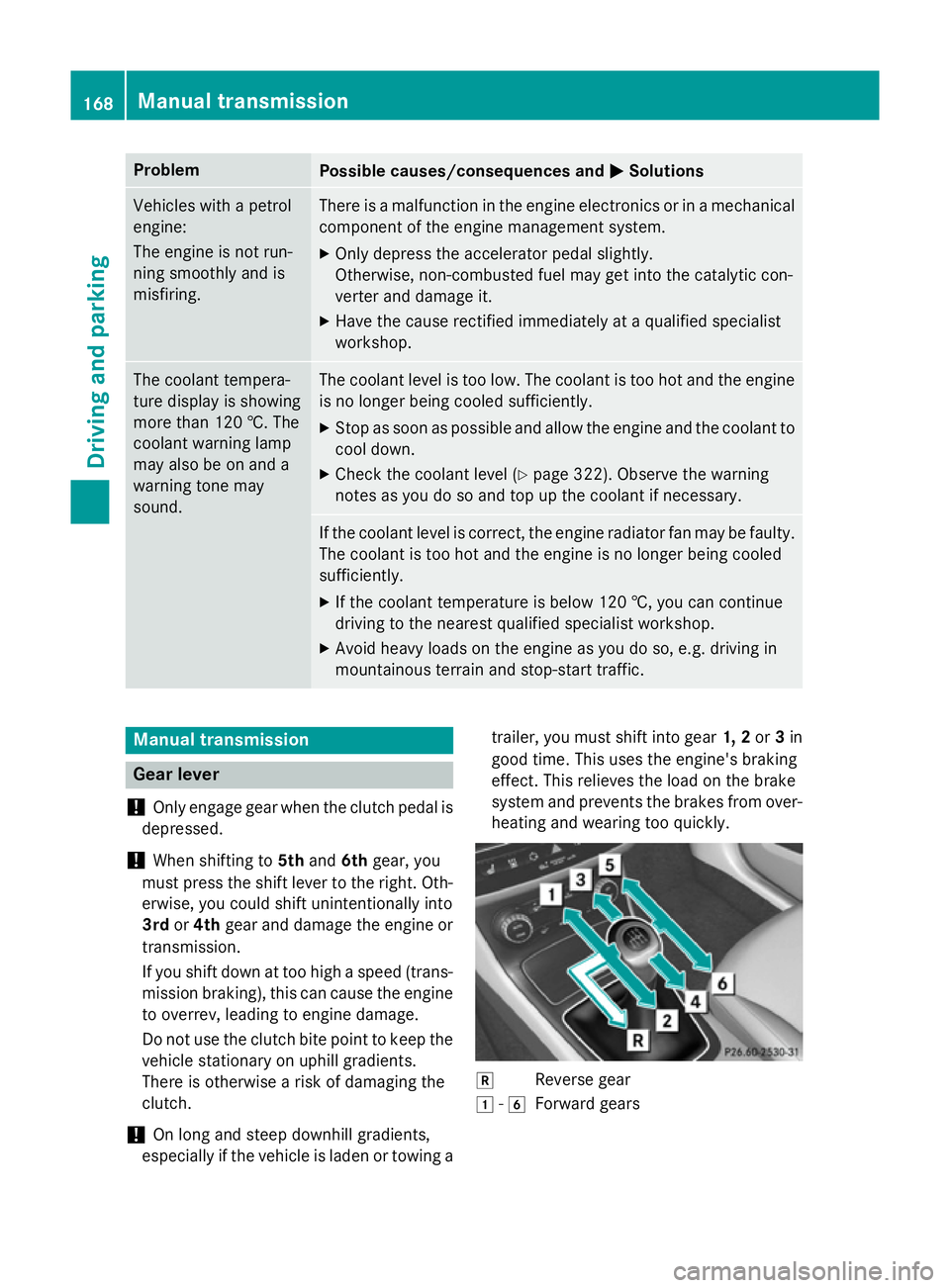
Problem
Possible causes/consequences and
M
MSolutions Vehicles with a petrol
engine:
The engine is not run-
ning smoothly and is
misfiring. There is a malfunction in the engine electronics or in a mechanical
component of the engine management system.
X Only depress the accelerator pedal slightly.
Otherwise, non-combusted fuel may get into the catalytic con-
verter and damage it.
X Have the cause rectified immediately at a qualified specialist
workshop. The coolant tempera-
ture display is showing
more than 120 †. The
coolant warning lamp
may also be on and a
warning tone may
sound. The coolant level is too low. The coolant is too hot and the engine
is no longer being cooled sufficiently.
X Stop as soon as possible and allow the engine and the coolant to
cool down.
X Check the coolant level (Y page 322). Observe the warning
notes as you do so and top up the coolant if necessary. If the coolant level is correct, the engine radiator fan may be faulty.
The coolant is too hot and the engine is no longer being cooled
sufficiently.
X If the coolant temperature is below 120 †, you can continue
driving to the nearest qualified specialist workshop.
X Avoid heavy loads on the engine as you do so, e.g. driving in
mountainous terrain and stop-start traffic. Manual transmission
Gear lever
! Only engage gear when the clutch pedal is
depressed.
! When shifting to
5thand 6thgear, you
must press the shift lever to the right. Oth- erwise, you could shift unintentionally into
3rd or4th gear and damage the engine or
transmission.
If you shift down at too high a speed (trans-
mission braking), this can cause the engine
to overrev, leading to engine damage.
Do not use the clutch bite point to keep the vehicle stationary on uphill gradients.
There is otherwise a risk of damaging the
clutch.
! On long and steep downhill gradients,
especially if the vehicle is laden or towing a trailer, you must shift into gear
1, 2or3in
good time. This uses the engine's braking
effect. This relieves the load on the brake
system and prevents the brakes from over-
heating and wearing too quickly. k
Reverse gear
1 -6
Forward gears 168
Manual transmissionDriving and parking